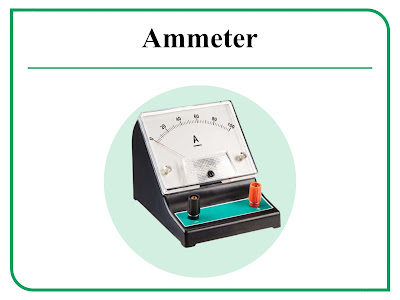In this article, we will study an electronic measuring device called an ammeter, which is a current-measuring device used to measure the amount of electric current flowing through an electric circuit.
What is an Ammeter?
In electrical and electronics, an ammeter is a measuring
device used for the measurement of the strength of an electric current flowing
through a circuit. It measures the electric current in amperes, hence its name
is ammeter, i.e. ampere meter.
The symbolic representation of an ammeter is shown in the
following figure.
Connection Diagram of Ammeter
The connection diagram of an ammeter in an electric circuit
is shown in the following figure.
In an electric circuit, the ammeter is always connected in series with the load. The series connection of an ammeter with the load allows it to carry the full current. This electric current flowing through the ammeter deflects the ammeter coil in proportion to the amount of current. A pointer is attached to the coil that can deflect on a calibrated scale to show the readings. This way an ammeter measures the electric current flowing through an electric circuit.
Specifications of Ammeter
Some important ammeter specifications are as follows:
- An ammeter is always connected in series with the circuit whose current is to be measured.
- An ammeter must have very low internal resistance, as it carries full load current in the circuit.
- An ideal ammeter always has zero internal resistance.
- An ammeter typically has a built-in fuse to protect it against accidental heavy currents flowing through it.
- Across an ammeter, a very small (ideally zero) voltage drop takes place due to its very low internal resistance.
Types of Ammeters
There are several different types of ammeters available as per
their construction or the nature of the measured current.
Types of ammeters based on the construction:
- Moving coil ammeter
- Moving iron ammeter
- Moving magnet ammeter
- Electrodynamometer ammeter
- Hotwire ammeter
- Integrated ammeter
- Digital ammeter
Types of ammeters based on measured current:
- AC ammeter
- DC ammeter
Effect of Temperature on Ammeter Operation
An ammeter typically has very low internal resistance.
However, this resistance can be changed due to changes in temperature. This may
lead to errors in measurement. To compensate for the effect of temperature on ammeter
operation, a resistance having zero temperature coefficient is connected in
series with it.
Applications of Ammeters
The following are some major applications of ammeters:
- Ammeters are used in various electrical circuits to measure the amount of current flowing through them.
- Ammeters are used in electrical power systems.
- Ammeters are also used in laboratories to perform experiments.
- Ammeters are also used with thermocouples to measure temperature.
- Ammeters are commonly used by electrical engineers and technicians to determine faults in electric circuits.
- Ammeters are also used by electronic device manufacturers to check the functionality of devices.
Hence, this is all about the ammeter and its applications. In conclusion,
an ammeter is one of the widely used electrical measuring instruments used to
measure the strength of the electric current flowing in an electric circuit.




.png)





0 Comments